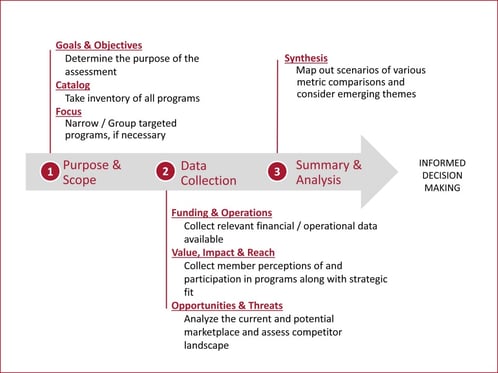August 14, 2013
Spring Cleaning: Assessing Your Program Portfolio – Part Two
Written by: McKinley Advisors
In my last post, Spring Cleaning: Assessing Your Program Portfolio, I discussed the benefits of a portfolio assessment. In this follow up post, I’ll go into more detail about the three main components of a portfolio assessment: Purpose & Scope, Data Collection, and Summary & Analysis.

I. Purpose & Scope
The first phase of a program assessment involves goal-setting, cataloging, and defining the scope. It can be quite overwhelming to dive into this type of analysis without a clear picture of what it is you want to get out of it, so setting goals is critical. You also want to set up the process by creating a catalog of all the programs and services currently being offered: itemizing offerings, grouping where possible, and providing the historical context of each where possible. For the scope, you should ask yourself if it’s realistic to conduct a comprehensive analysis of the entire program portfolio or if you should adopt a phased approach.
II. Data Collection
The next component is data collection. This is where you can get an accurate financial picture of the portfolio today, and where you see what’s working and what’s not working. What programs require the greatest resources? Which programs help support less profitable ones? The next type of data collection involves gathering member perspectives on the value and importance of programs, along with information on the level of member participation. In addition, you should gather data that can help you understand how well the program is aligned to the strategic objectives of the organization. A thorough program assessment includes external factors in the analysis. These macro-environmental factors, such as the competitive landscape or industry trends, can help explain the performance of some programs.
III. Summary & Analysis
So now you have all of the information available – you’ve collected data on members’ impressions and awareness of existing programs and you have a clear picture of hard and soft costs, linked to programs. Now what? Through the use of analytic tools—such as dashboards and matrices—you can map out where program attributes fall in relation to one another. These visual tools compare relative levels of impact, value, revenue and other metrics to help identify the “sacred cows,” “low-hanging fruit” and potential “long-term winners,” as well as those programs that are labor-intensive and falling short of member needs and expectations.
One final consideration: it’s important to keep in mind that priorities change. Management turnover, shifts in the market—many things happen that affect an association’s program structure and strategy. A portfolio assessment should be thought of as a continuous process, not a one-time event.
Tag(s):
McKinley Advisors
McKinley Advisors is an award-winning association consulting firm dedicated to accelerating associations’ positive impact on the world. McKinley works in partnership with association executives and volunteer leaders to identify and address their most significant challenges and opportunities. McKinley provides services...
Business Models
5 min read
| November 12, 2025
Is Your Association Ready for a Portfolio Analysis?
Read More
Market Research
8 min read
| October 24, 2025
What Your Association Should Expect from Research Partners
Read More
featured
10 min read
| August 20, 2025






